Previous Book & Author Reviews
April Book Display, RVM Library
by Anne Newins
This month we highlight five authors (listed below) who may not be on current bestseller lists, but who are worth reading for the first time, or re-reading when reminded how much you enjoyed them the first time.
Tony Hillerman was best known for his Navajo Tribal Police mysteries. But many fans enjoyed the Four Corners setting and descriptions of Navajo history and culture as much as the mysteries.
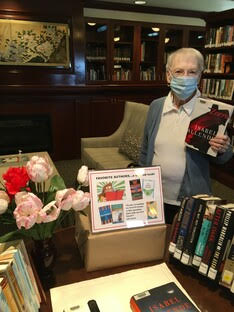
Reader Marie Terhune browses the April book display
Patrick O’Brian wrote nearly twenty nautical history novels set during the Napoleonic wars and featured the friendships between several members of the Royal Navy. The books had international fame until after OBrian’s death in 2000.
P. D. James received many honors during her lifetime for her distinguished accomplishments (of which there were many), eventually receiving the title of Baroness James of Holland Park. She wrote crime thrillers and dystopian fiction. Her best known novels feature Adam Dalgliesh, a poet and detective at Scotland Yard.
Isabel Allende, internationally famed for her work, also has received numerous awards. Her novels are varied in subject, and often include historical events as well as magical realism.
Philip Margolin specializes in legal thrillers. A prolific writer, his books include several series as well as stand-alone novels.
Book Review: Waters of Eternal Youth by Donna Leon

Bonnie Tollefson
Reviewed by Bonnie Tollefson
Waters of Eternal Youth is number 25 in the Guido Brunetti series. This series is set in present day Venice, Italy. The author, Donna Leon, was born in New Jersey but spent over 30 years of her life living in Venice and her love and intimate knowledge of the city and life in the city comes thru. Each book, while working on a crime deals with a different issue facing the city, be it environmental issues, the flooding, the treatment of immigrants or the 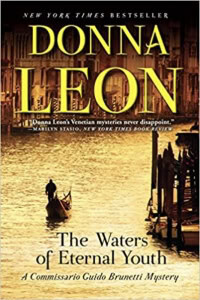 people’s attitudes toward those not like themselves. Commisario Brunetti is married to a professor who loves the writings of James. He has two children who we watch thru the series as they grow and mature. In this book, Brunetti is asked to looked into a case by his mother-in-law’s close friend. First, he must convince his shallow and self-centered boss that there is something worth pursuing about the case. In Waters of Eternal Youth, the case gets solved and the bad guy goes to jail, even tho it is not for the original crime, but not all of Leon’s books end happily. Some end with the ambiguity that is a part of life. Commisario Brunetti and his co-workers may know who committed a crime but proof is not available or the bad guy dies or moves or disappears before punishment. Sometimes it is the fault of the Italian legal system and sometimes it is just the way life is. Donna Leon is 78 years old and lives in Switzerland after becoming a Swiss citizen but is still writing about Venice.
people’s attitudes toward those not like themselves. Commisario Brunetti is married to a professor who loves the writings of James. He has two children who we watch thru the series as they grow and mature. In this book, Brunetti is asked to looked into a case by his mother-in-law’s close friend. First, he must convince his shallow and self-centered boss that there is something worth pursuing about the case. In Waters of Eternal Youth, the case gets solved and the bad guy goes to jail, even tho it is not for the original crime, but not all of Leon’s books end happily. Some end with the ambiguity that is a part of life. Commisario Brunetti and his co-workers may know who committed a crime but proof is not available or the bad guy dies or moves or disappears before punishment. Sometimes it is the fault of the Italian legal system and sometimes it is just the way life is. Donna Leon is 78 years old and lives in Switzerland after becoming a Swiss citizen but is still writing about Venice.
The Rogue Valley Manor library has 26 of the 30 books in this growing series, however number 30 just came out in March of 2021 and I would expect that one to be added soon.
Past Reviews:
1. Flight, A Celebration of 100 Years in Art and Literature — Book Review (Caldwell)
2. Apeirogon — Book Review (Kent)
3. The Mystery of Mrs. Christie — Book Review (Hines)
4. Richard Wagamese — Author Review (Fautin)
5. Why We Sleep — Book Recommendation (Corbett)
6. Credible Threat — Book Review (Tollefson)
7. Hamnet — Book Review (Newins)
8. William Kent Krueger — Author Review (Fautin)
9. Secondhand — Book Review (Newins)
10. Karen Louise Erdrich — Author Review (Fautin)
Book Review: Flight, A Celebration of 100 Years in Art and Literature, by Anne Collins
reviewed by Liz Caldwell
“I have been afflicted with the belief that flight is possible for man.” Wilbur Wright 1900
 Since before the time of Icarus, human have dreamt of flying like birds to the heavens, home of the gods. In Greek mythology, Icarus flew too close to sun, fatally melting the wax of his wings. And little over 100 years ago, this dream of flight was realized by the Wright Brothers. Since that time, humans have achieved unimagined flight; breaking the sound barrier, landing on the moon, and living in a Space Station. This invention of the airplane has revolutionized the human experience, literally shaping our view of the world. It is arguably the defining technology of the twentieth century.
Since before the time of Icarus, human have dreamt of flying like birds to the heavens, home of the gods. In Greek mythology, Icarus flew too close to sun, fatally melting the wax of his wings. And little over 100 years ago, this dream of flight was realized by the Wright Brothers. Since that time, humans have achieved unimagined flight; breaking the sound barrier, landing on the moon, and living in a Space Station. This invention of the airplane has revolutionized the human experience, literally shaping our view of the world. It is arguably the defining technology of the twentieth century.
The anthology “Flight A Celebration of 100 Years in Art and Literature” honors this with an historical overview through art and literature. It was written in collaboration with NASA with editors Anne Collins Goodyear, Assistant Curator at the National Portrait Gallery; Roger Lanius of the Smithsonian’s National Air and Space Museum; Anthony Springer, NASA Manager and Test Engineer; and Bertram Ulrich, painter and curator of the NASA Art Program.
There are chapters on Aviation Invention, Heroic Age, War, Transportation, Space Flight, and Reaching for Stars. It is arranged chronologically from Octave Chanute, whom the Wrights acknowledge as a mentor, to Frank L. Culbertson who spent over 125 days in the International Space Station in 2001. It contains personal reflections by leading aviation pioneers such as the Wright Brothers, Louis Bleriot (who flew across the English Channel in 1900), Amelia Erhart (the first woman to fly solo across the Atlantic), Charles Lindbergh (who first soloed across the Atlantic), and his wife Anne Morrow (who served as her husband’s co-pilot, navigator, and radio operator in charting commercial air routes), Captain Edward V. Rickenbacker (America’s leading Ace in WWI and later CEO of Eastern Airlines), Benjamin O. Davis, Jr. (who led the famous Tuskegee Airmen becoming the first African American to achieve Brigadier General), General Jimmy Doolittle (who led the first carrier-based bomber attack on mainland Japan), and Chuck Yeager (who broke the sound barrier.)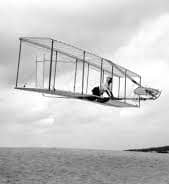
It is lavishly illustrated with over 85 Paintings and graphics including “Photo of the First Wright brothers’ flight December 17, 1903”; Pablo Picasso “Nortre Avenir est dans l’Air” 1912; Henri Rousseau “Pecheurs a’ la linge avec aero plane” ; Roy Lichtenstein” Whaam!” 1963; Georgia O’Keeffe “Sky above Clouds IV” 1965; Norman Rockwell “Grissom and Young Suiting Up” 1965; Yvonne Jacquette “Oregon Valley, Overcast Day II” 1995; Charles M. Schultz “Snoopy and the Red Baron” 1966 ; Robert T. McCall “The Spirit of Flight Research” 1977; Andy Warhol “Moonwalk” 1987; Roy Lagrone 1988 “Woody Driver — Black Birdman (Tuskegee Airman)”; and Anne Leibovitz “Eileen Collins” 1999;
Writings are from from President John Fitzgerald Kennedy, Broadcaster Walter Cronkite , and a stunning selection of authors from the world of aviation, science fiction, literature, science, and politics; with Ray Bradbury, Carl Sagan, Norman Mailer, Robert Heinlein, James Michener, Jules Verne, Antoine de Saint-Exupery, and John Travolta (actor / pilot / Quantas Airlines Ambassador at Large), plus poetry from Robert Frost, William Butler Yates, Robert Heinlein; Rudyard Kipling, Joni Mitchell (singer/song writer with 21 albums in 30 years) and others.
From “High Flight” 1941 by John Gillespie Magee, Jr (who died at age 19 in a WWII Spitfire)
“Oh, I have slipped the surly bonds of earth
And danced the skies on laughter-silvered wings;
. . .
Put out my hand, and touched the Face of God.”
“Flight A Celebration of 100 Years in Art and Literature”
is available in the RVM Library as #4638 and is part of the Library’s March Book Display “Celebrating the First 100 Years of Aviation.”
Illustration: “Compression and Penetration” Nixon Galloway, 1985
——————————————————————————————————————————————————————————————————————–
Book Review: Apeirogon, by Colum McCann
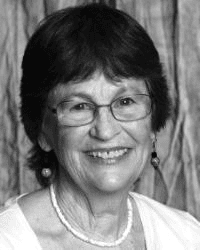
Connie Kent
reviewed by Connie Kent
A horrible book. Horrible and horrifying. It’s shocking, distressing, confusing, sad. And it’s true.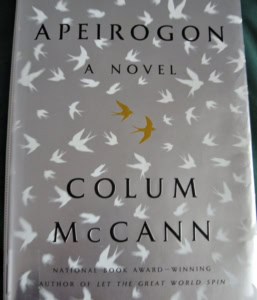
![]()
This disturbing tale is presented as a novel set in contemporary times. An Israeli man and a Palestinian man each lost a daughter to violence. The Palestinian man’s ten-year-old daughter was hit in the back of the head with a rubber bullet (a metal bullet with a rubber coating) as she stood outside a candy store with her friends during a morning break from school. The shooter was an eighteen year old Israeli soldier. Ten years earlier, the thirteen year old daughter of the Israeli was one of several victims of a Palestinian suicide bomber. Eventually, the men became friends participating in an organization that presents lectures worldwide, educating the rest of us and urging peace.
It’s a long book. It has 1001 chapters. Some are as short as one sentence, others cover several pages. Chapter numbers reach a peak in the middle and then reverse back to chapter one in the second half.
‘Apeirogon’ means “a shape with a countably infinite number of sides.” How can that be? It comes up several times in the book. It may refer to the infinite number of sides of the Israeli-Palestinian conflict, with people of many different nations having a share; it may refer to the fact that, if you follow the line around the figure, you always come back to the starting point. That was explained somewhere in the book. It’s an unhappy story, a horrifying book – not a happy read. But it’s an important one.
McCann, Colum. Apeirogon. Random House, 2020.
———————————————————————————————————————————————————————————————————————-
Book Review: The Mystery of Mrs. Christie, by Marie Benedict
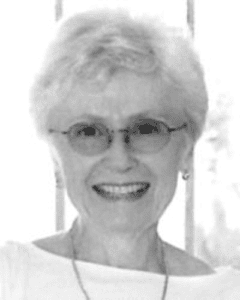
Jan Hines
reviewed by Jan Hines
I LOVE A MYSTERY! Most of us remember reading Nancy Drew and the Hardy Boys detective novels when we were kids. As we grew older we graduated to adult fiction and often our mystery books of choice were those written by British author, Agatha Christie.
Christie created two memorable protagonists to unravel the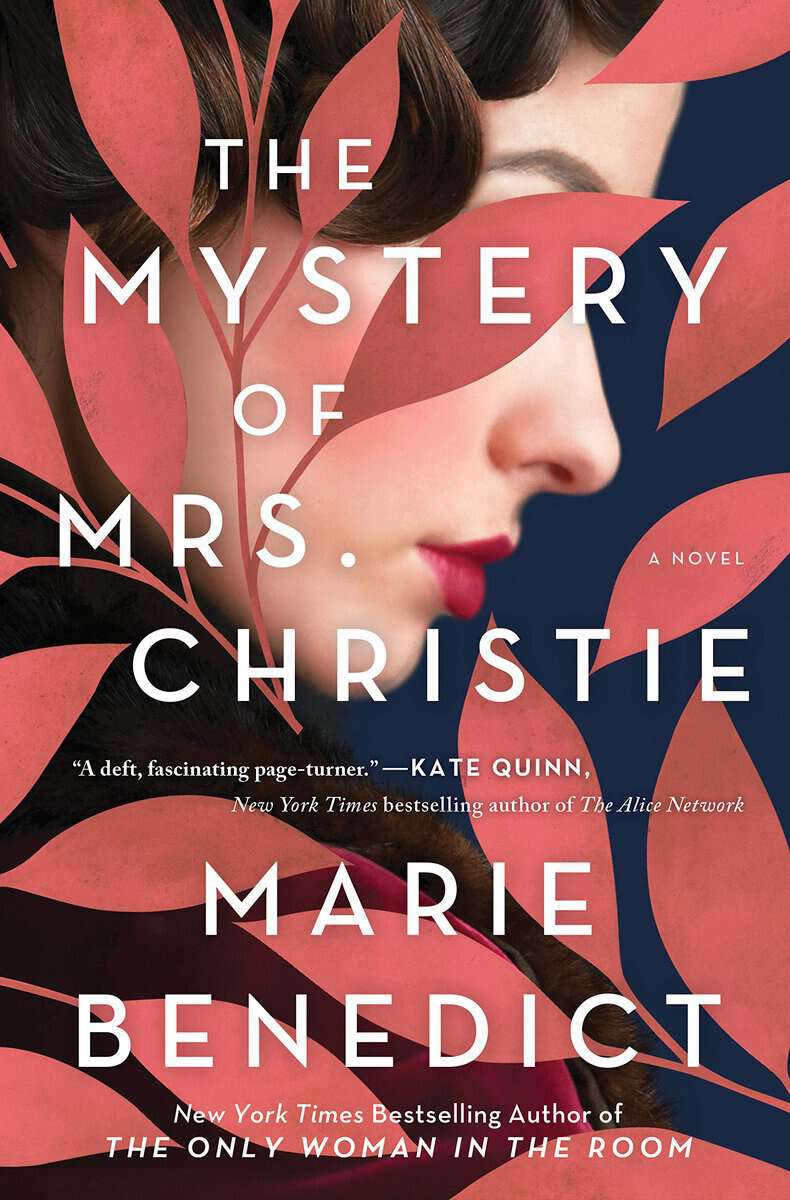 puzzles in her stories, the unassuming Miss Jane Marple and dapper Belgian Hercule Poirot. Yet, while these two super sleuths were busy solving every crime that came their way, no one has managed to find the answer to Christie’s real life mystery, her unexplained disappearance on December 3, 1926.
puzzles in her stories, the unassuming Miss Jane Marple and dapper Belgian Hercule Poirot. Yet, while these two super sleuths were busy solving every crime that came their way, no one has managed to find the answer to Christie’s real life mystery, her unexplained disappearance on December 3, 1926.
An extensive manhunt was initiated by the police when the famous author was reported missing, joined by citizens and celebrities such as Arthur Conan Doyle. No clues to her disappearance turned up except for her car found at the edge of a nearby pond. Her husband Archie, suspected of her murder by those with knowledge of Christie’s troubled marriage, was absolved when Christie reappeared 11 days later at a Yorkshire spa. Agatha Christie, an intensely private person, gave no explanation for her disappearance other than amnesia, and did not include the curious episode in her autobiography. Several books and a movie have offered various scenarios to fill in the missing 11 days, but none seemed convincing until author Marie Benedict introduced a bold, compelling version in her new book, The Mystery of Mrs. Christie.
Agatha Christie handed the world an unsolvable mystery. The question for readers to
answer is whether Marie Benedict, following in Jane Marple’s footsteps, found the solution to the mysterious case. The Mystery of Mrs. Christie is a new addition to the RVM Library.
Marie Benedict is a graduate of Boston College and Boston University of Law, a lawyer and best selling author of Lady Clementine and The Only Woman in the Room. She lives in Pittsburgh with her family.
——————————————————————————————————————————————————————————————————————–
Author Review: Richard Wagamese
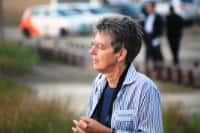
Daphne Fautin
by Daphne Fautin
Like author Karen Louise Erdrich and the protagonist of William Kent Krueger’s books (both reviewed below), Richard Wagamese was also an Ojibway. What is it about these people? They all seems to be writers! But unlike the other two, rather than living in the Twin Cities, he was Canadian. He belonged to the Wabaseemoong Independent Nations in what is now known as northwestern Ontario, but he lived in British Columbia. He was raised in a foster home in Ontario, and suffered many forms of abuse, including losing contact with his heritage. He experienced and wrote about the losses and hardships imposed on native peoples.
Medicine Walk, which was published in 2014 and is being read by one of RVM’s many book groups, won the 2015 Banff Mountain Book Festival Grand award. It was not Wagamese’s only award, and a movie was adapted from his 2012 book Indian Horse.
———————————————————————————————————————————————————————————————————————
Book recommendation: Why we sleep : unlocking the power of sleep and dreams by Matthew P. Walker
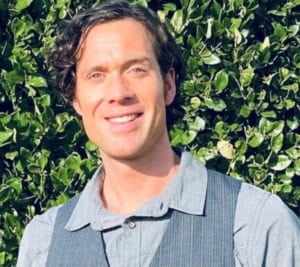
Tim Corbett
Wellness Department Manager Tim Corbett recommended the following book in his “Wellness Minute” on the Importance of Sleep in Good Day RVM. Adapted from the RVM Library post to RVMlist on 1/1/2021. The book is available in the RVM Library as #9096, shelved at 612.8 Walker in non-fiction regular print.
” Why We Sleep is an important and fascinating book…Walker taught me a lot about this basic activity that every person on Earth needs. I suspect his book will do the same
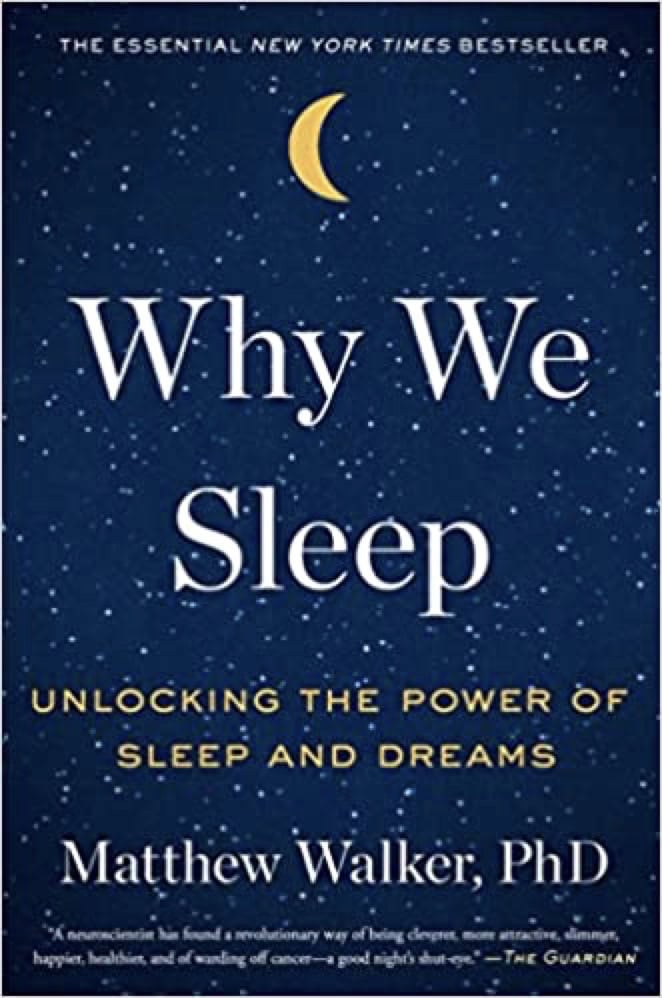
Why We Sleep
for you.” –Bill Gates A New York Times bestseller and international sensation, this “stimulating and important book” ( Financial Times ) is a fascinating dive into the purpose and power of slumber. With two appearances on CBS This Morning and Fresh Air ‘s most popular interview of 2017, Matthew Walker has made abundantly clear that sleep is one of the most important but least understood aspects of our life. Until very recently, science had no answer to the question of why we sleep, or what good it served, or why we suffer such devastating health consequences when it is absent. Compared to the other basic drives in life–eating, drinking, and reproducing–the purpose of sleep remains
more elusive. Within the brain, sleep enriches a diversity of functions, including our ability to learn, memorize, and make logical decisions. It recalibrates our emotions, restocks our immune system, fine-tunes our metabolism, and regulates our appetite. Dreaming creates a virtual reality space in which the brain melds past and present knowledge, inspiring creativity. In this “compelling and utterly convincing” ( The Sunday Times ) book, preeminent neuroscientist and sleep expert Matthew Walker provides a revolutionary exploration of sleep, examining how it affects every aspect of our physical and mental well-being. Charting the most cutting-edge scientific breakthroughs, and marshalling his decades of research and clinical practice, Walker explains how we can harness sleep to improve learning, mood and energy levels, regulate hormones, prevent cancer, Alzheimer’s and diabetes, slow the effects of aging, and increase longevity. He also provides actionable steps towards getting a better night’s sleep every night. Clear-eyed, fascinating, and accessible, Why We Sleep is a crucial and illuminating book. Written with the precision of Atul Gawande, Andrew Solomon, and Sherwin Nuland, it is “recommended for night-table reading in the most pragmatic sense” ( The New York Times Book Review.)
————————————————————————————————————————————————————————————————–
Credible Threat, by J. A. Jance (Gallery Books, 2020)

Bonnie Tollefson
Reviewed by Bonnie Tollefson
Credible Threat is the 15th in the Ali Reynolds series. Ali was a broadcast journalist in California until she was replaced by a “younger face”. Out of a job and divorcing a cheating 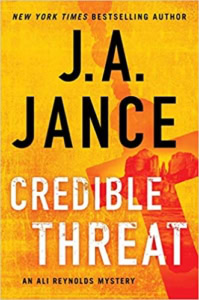 husband, Ali returns home to Arizona. Thru the years, Ali inherits a house, a job and a butler; marries a younger man, B. Simpson who owns a cybersecurity firm; and develops an eclectic group of friends including an octogenarian nun and an artificial intelligence named Frigg.
husband, Ali returns home to Arizona. Thru the years, Ali inherits a house, a job and a butler; marries a younger man, B. Simpson who owns a cybersecurity firm; and develops an eclectic group of friends including an octogenarian nun and an artificial intelligence named Frigg.
In Credible Threat, Rachel Higgins is introduced. Rachel is the wife of a domineering husband and mother of a son who died in his 20’s of an accidental(?) overdose. Quite by accident,
Rachel discovers that her son was the probable victim of his high school swimming coach, a pedophile priest. Father Needham was tried, convicted and sent to prison for abusing other boys, where he died of Aids so he is beyond the reach of Rachel’s wrath. She settles her desire for vengeance on Archbishop Francis Gillespie of Phoenix. All summer she sends him threatening notes in Sunday offering plates all over Phoenix. Archbishop Gillespie takes the notes to the police but they say he is a public figure and must expect such and they do not find the threats credible. Still worried, Archbishop Gillespie turns to acquaintances B. Simpson and Ali Reynolds and their cybersecurity company High Noon Enterprises. With B. called out of the country by a cybersecurity emergency, Ali, with the able assistance of Frigg, is on her own to identify Rachel, free a framed innocent man, and save the life of the archbishop, not easy tasks.
The Rogue Valley Manor library has 13 of the 15 books in this growing series. Number 16 is due out in June of 2021.
Editor’s comment: I have to confess having trouble with the dramatis personae – an Artificial Intelligence sidekick? But hey, if that’s what they write about, we gotta have reviews. I may eventually have to read one if I can’t get that out of my mind.
Reviewer’s reply: I think you would enjoy Frigg. She started out as AI for a bad guy but she knew he was going down because he wouldn’t listen to her advice. She hid herself in the Cloud and after much research sent her access info to High Noon Enterprises (definitely the good guys). They access her with much trepidation and have tried to teach her ethics, but when the chips are down she still gets info she legally shouldn’t have. Helps move the story along though.
Frigg with bad guy – Man Overboard
Frigg activated by good guy – Duel to the Death
———————————————————————————————————————————————————————————————————————–
Book Review: Hamnet: A Novel of the Plague, by Maggie O’Farrell (Alfred A. Knopf, 2020)
by Anne Newins

Anne Newins
Irish author Maggie O’Farrell has created a lush and luminous fictional rendering of William Shakespeare’s family life during the Black Death in the late 16th century. Actual factual details of Shakespeare’s domestic life are limited, allowing the author to create a complex set of relationships both within the family and the community of Stratford. The book begins with a few brief, historical sentences:
“In the 1580s, a couple living on Henley Street, Stratford, had three children: Susanna, then Hamnet and Judith, who were twins.
The boy, Hamnet, died in 1596, aged eleven.
Four years or so later, the father wrote a play called Hamlet.”
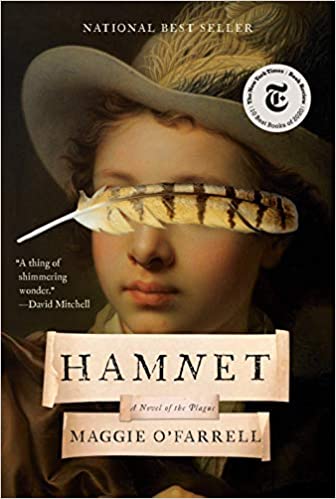 From this point forward, the book becomes O’Farrell’s own, to the point that nowhere in the book is Shakespeare ever referenced by name. He always is “the father,” “the author,” or “the husband.” Anne Hathaway becomes “Agnes,” the name used in her father’s will. The names Hamnet and Hamlet were used interchangeably at the time.
From this point forward, the book becomes O’Farrell’s own, to the point that nowhere in the book is Shakespeare ever referenced by name. He always is “the father,” “the author,” or “the husband.” Anne Hathaway becomes “Agnes,” the name used in her father’s will. The names Hamnet and Hamlet were used interchangeably at the time.
The book is written primarily from Agnes’s and Hamnet’s perspectives, not Shakespeare’s. The plot weaves between the couple’s early romance, the tragic effects of the plague on their children and surrounding communities, and the consequences of Shakespeare’s success on the family. Nonconformist Agnes is a falconer and herbalist, constantly trying to find cures for the era’s many ailments. Hamnet is inextricably devoted to his twin, Judith. Other characters, including loathsome in-laws, are vividly portrayed.
To me, some of the most compelling parts of the novel are the rich natural descriptions, such as the following depiction of a forest. “You might find it a restless, verdant, inconstant sight; the wind caresses, ruffles, disturbs a mass of leaves; each tree answers to the weather’s ministrations at a slightly different tempo from its neighbor, bending and shuddering and tossing its branches, as if trying to get away from the air, from the very soil that nourishes it.”
A copy is available in the RVM library.
————————————————————————————————————————————————————————
Author Review: William Kent Krueger
by Daphne Fautin

Daphne Fautin
William Kent Krueger is the author of a series of stories featuring the quarter-Ojibwe detective Cork O’Connor. Krueger also has published three stand-alone books, This Tender Land, The Devil’s Bed, and Ordinary Grace. The last was read by one of the book groups on campus. Seventeen of the detective stories plus all three of the other books he has written are in the RVM library.
Born in Torrington, Wyoming, Krueger now lives in St. Paul, Minnesota, which plays an important role in This Tender Land. His detective stories are set in the fictional county of Tamarack in northern Minnesota (abutting the Boundary Waters). O’Connor, who was once sheriff of the county and then became a PI, is married to an Anglo attorney (like Krueger himself). Unlike Barbara Erdrich, a part Ojibwee author whose characters and settings are sometimes similar to Krueger’s, he is not a Native American. However, This Tender Land and The Devil’s Bed have long passages lauding family, and characters in both include part Indian children although they are not Ojibwe or Cree.
Words from the Ojibwe and Cree languages are scattered throughout the O’Connor books, but O’Connor lives off the reservation, much like a white man (although he does go into a sweat lodge). An important character is Henry Meloux, an Ojibwe medicine man (Mide), who fills a role similar to that of Tony Hillerman’s Navajo detective, Joe Leaphorn, and Henry Standing Bear in Craig Johnson’s detective stories that are set in the counterpart fictional Absoroka county in Wyoming. (Wyoming would be the first rather than last state alphabetically if the original proposal to name it after the indigenous Absoroka tribe instead of the Pennsylvania Wyoming tribe had been accepted).
Krueger is both novelist and mystery writer, and with mystery writers Hillerman and Johnson and novelist Erdrich, is part of a group of American authors who feature Native American characters and themes. William Kent Krueger

——————————————————————————————————————————————————————————————————————-
Book Review: Secondhand: Travels in the New Global Garage Sale, by Adam Minter (Bloomsbury, 2019)

Anne Newins
Reviewed by Anne Newins
Have you ever wondered what happens to all of the items you have donated to the Foundation, Goodwill, garage sales, or the many other outlets for secondhand goods? The Medford area alone has at least thirty businesses handling secondhand goods.

Adam Mintner
Secondhand is a fascinating account of where many of these goods may finish up. Adam Minter, a columnist
for Bloomberg World View, has a long history of involvement with the subject. He currently is based in Shanghai. His great grandfather, an immigrant, started out as a rag picker in Texas, and the family eventually moved into selling scrap metal in Minnesota. This led Minter into a journalism career focusing on global recycling. His first book was Junkyard Planet. Minter is an engaging and lively writer.
The book also would appeal to people who enjoy travel writing. Minter recounts how the secondhand trade takes place in Arizona, Minnesota, Japan, Mexico, the United States, India, Ghana, Malaysia, and numerous other countries. He provides profiles of the interesting people and companies involved in the trade and makes it clear that these are skilled businesspeople, whatever their level of income.
The glut of secondhand goods originated after the Industrial Revolution since people now had the ability to buy and discard belongings. Mass production and increased prosperity allowed people to buy many possessions, including clothing, appliances, furniture and other durables. Over time, and particularly in the 1970’s, garage sales gained popularity in order to dispose of unwanted goods and buy yet more. Exports to other countries developed when wealthier nations could not absorb all of the used items and it became more profitable to export them, both for the exporting and importing countries.
Minter notes that obtaining accurate figures about the trade is difficult because much of it occurs informally, and in many cases, illegally. But the available statistics about the extent of the secondhand trade are astounding. For example:
- According to the EPA, in 2015, Americans tossed out 24.1 billion pounds of furniture and furnishings.
- About 30% of textiles collected from recycling in the United States are converted into wiping rags.
- Bookoff, Japan’s largest used bookseller, sends thirty-five tons of unsold books to paper recyclers every year.

Unsurprisingly, Minter is an advocate of global recycling. He has grave concerns about countries that try to limit exports of used technology or other goods to other countries, citing numerous examples of entrepreneurs who repair and resell old television sets, computers, telephones, and other devices that would otherwise would be unaffordable to citizens of developing nations. Access to this technology allows them to improve their own livelihoods and that of their nations.
In his preface, Minter states that readers “will find a surprising world where what’s old becomes new again, over and over, and the desire to profit from castoffs creates innovations and livelihoods—all over the world at all hours of the day.” Secondhand lives up to this claim.
A gently used copy of the book has been donated to the Manor library.
——————————————————————————————————————————————————————————————————————–
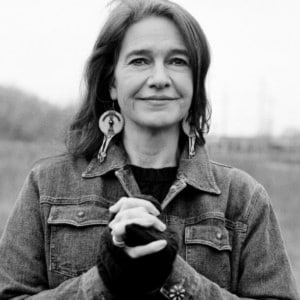
Louise Erdrich
Author Review: Karen Louise Erdrich

Daphne Fautin
Reviewed by Daphne Fautin
This is the first of what is hoped to be a series of author profiles of books read by RVM book groups.The Round House, winner of the National Book Award for Fiction and the 14th novel published by Louise Erdrich, was read by one of the groups on campus. Actually, it was read twice, as one of the members belatedly recalled – but she was the only one who remembered, and given the turn-over in book group membership, this is no surprise. The second reading was after deciding to read it instead of The Night Watchman. Both are in the RVM library – along with four others by Erdrich. Those, and many others, are available at the Jackson County libraries, too.
Karen Louise Erdrich (to give her full name), is the author of novels, short stories, poems (she conducts poetry workshops), memoirs, and children’s books, most dealing with Native American subjects. She is an enrolled member of the Turtle Mountain Band of the Anishinaabe (also known as Ojibwe and Chippewa). Her mother, Rita Gourneau was half Ojibwe and half French; her father was Ralph Erdrich, an American of German ancestry. They met teaching at a BIA school in North Dakota. Her grandfather, Patrick Gourneau, was the subject of Erdrich’s recent book, The Night Watchman. But that was not his only occupation – he served for many years as tribal chairman for the Turtle Mountain Band of Chippewa Indians. She told an interviewer that when she begins writing, she does not know the outcome of the story, and that is why writing The Night Watchman was so difficult for her – she knew exactly where it was going.
She lives in Minneapolis, where she and her sister, Heidi, have a store, Birchbark Books, Herbs, and Native Arts, and a small nonprofit publisher, Wiigwaas Press. She attended Dartmouth College and Johns Hopkins University. At Dartmouth, she met anthropologist Michael Dorris, who had adopted three Native American children. She coauthored several books with him, and, once they had married, had three children. He committed suicide (as they were divorcing or shortly after – reports differ) in 1997. Since then she has had another child, whose (Native American) father she has declined to name.


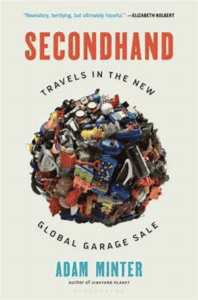

Leave a Reply
Want to join the discussion?Feel free to contribute!